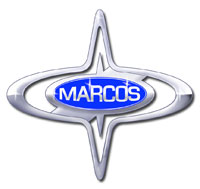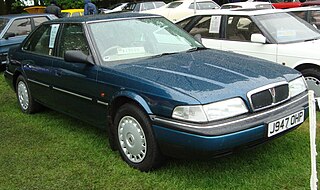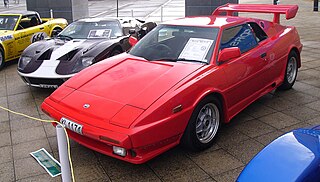
The Morris Marina is a front-engined, rear-wheel-drive small family car that was manufactured by the Austin-Morris division of British Leyland from 1971 until 1980. It served to replace the Morris Minor in the Morris product line, which had first been built in 1948. The Marina was also sold in some markets as the Austin Marina, the Leyland Marina and the Morris 1700.

Marcos Engineering was a British sports car manufacturer. The name derives from the surnames of founders Jem Marsh and Frank Costin.

The Rover 800 series is an executive car range manufactured by the Austin Rover Group subsidiary of British Leyland, and its successor the Rover Group from 1986 to 1999. It was also marketed as the Sterling in the United States. Co-developed with Honda, it was a close relative to the Honda Legend and the successor to the decade-old Rover SD1.

The Triumph GT6 is a 6-cylinder sports coupé built by Standard-Triumph, based on their popular Triumph Spitfire convertible. Production ran from 1966 to 1973.

The Triumph Herald is a small two-door car introduced by Standard-Triumph of Coventry in 1959 and made through to 1971. The body design was by the Italian stylist Giovanni Michelotti, and the car was offered in saloon, convertible, coupé, estate and van models, with the latter marketed as the Triumph Courier.

The Triumph Vitesse is a compact six-cylinder car built by Standard-Triumph from 1962 to 1971. The car was styled by Giovanni Michelotti, and was available in saloon and convertible variants.

The MGB is a two-door sports car manufactured and marketed from 1962 until 1980 by the British Motor Corporation (BMC), later the Austin-Morris division of British Leyland, as a four-cylinder, soft-top sports car. It was announced and its details first published on 19 September 1962. Variants include the MGB GT three-door 2+2 coupé (1965–1980), the six-cylinder sports car and coupé MGC (1967–1969), and the eight-cylinder 2+2 coupé, the MGB GT V8 (1973–1976).

Fairthorpe Ltd was a British manufacturer of motorcars, active between 1954 and 1973. Production was in Chalfont St Peter, Buckinghamshire, England between 1954 and 1961, from 1961 to 1973 in Denham, Buckinghamshire.

Gilbern, Gilbern Sports Cars (Components) Ltd , was a Welsh car manufacturer from 1959 to 1973, based in Llantwit Fardre, Pontypridd, Glamorgan, Wales.

Ginetta Cars Limited is a British specialist builder of racing and sports cars based in Garforth, Leeds, West Yorkshire.

The Smart Roadster (W452) is a two-door, two-seater sports car classified in the S-segment in Europe. It was first introduced in 2002 by Smart GmbH. The Roadster and its variant, the Roadster Coupé, enjoyed mostly successful sales during their production run. In total, approximately 43,000 units were produced before the model was discontinued in November 2005. The final Smart Roadster built now resides in the Mercedes-Benz Museum. It is defined by a consortium between Switzerland (Swatch), Germany (Mercedes-Benz) and France, whose vehicle remains "Made in France" because it is built entirely at its Hambach factory in Moselle.

Locust is a kit car inspired by the Lotus Seven. It was first developed in the mid 1980s as a cheap kit car to be built onto the chassis of a Triumph Spitfire, it was later developed into a full kit car which used its own fully designed ladder chassis - unlike others using space frame. The car was famed for its cheap to build construction using marine ply for the body, which was then covered with aluminium sheeting, the last kits were produced in early 2000.
Dutton Cars, based in Worthing, Sussex, England, was a maker of kit cars between 1970 and 1989. In terms of number of kits produced, it was the largest kit-car manufacturer in the world.
Sylva Autokits is a kit car manufacturer based in Lincolnshire, England. Sylva was founded in 1981 by Jeremy Phillips and has developed and produced a number of small and lightweight sports cars. Sylva cars have won a number of 750 Motor Club Kit Car championships.

The Triumph Dolomite is a car that was produced by Triumph Motor Company from 1934 to 1940. It first appeared in 1934 as a sports car and the name was also used from 1937 on a series of sporting saloons and open cars until 1939 when the company went into receivership. A number were still sold and registered in 1940, though it is uncertain whether the receiver or new owner turned out cars from spare parts, or sold off completed cars. All except the Straight 8 featured a "waterfall" grille styled by Walter Belgrove, versions of the saloons with conventional grilles were sold as Continental models.

Spartan Cars was a manufacturer of kit cars which operated from 1973 to 1995 initially based in Mapperley Plains, Nottingham moving in 1978 to Pinxton, Derbyshire, United Kingdom. The company was founded by Jim McIntyre, who had been running a vehicle repair business in Nottingham. The name was not a reference to the Spartan fighters, so much as a tongue-in-cheek reference to the economic conditions in the United Kingdom at the time the company was first formed.

The TVR M series is a line of sports cars built by automaker TVR between 1972 and 1979. The series replaced the outgoing TVR Vixen and Tuscan models, and is characterized by a common chassis and shared body style. As with other TVR models before and since, the M-series cars use a front mid-engine, rear-wheel drive layout and body-on-frame construction. The bodies themselves were built from glass-reinforced plastic (GRP). The era of the M series is commonly associated with Martin Lilley who, together with his father, took ownership of the company on 30 November 1965.

The Triumph Fury is a prototype two-door drophead coupé commissioned by the Standard-Triumph Company of Coventry, England. It was the first Triumph sports car built on a unitary construction platform.

Heron Cars were racing cars, sports and kit cars built in New Zealand between 1962 and 1999 by Ross Baker. They also included a one-off electric car.
Caburn Engineering Limited is a British manufacturer of automobiles.
























